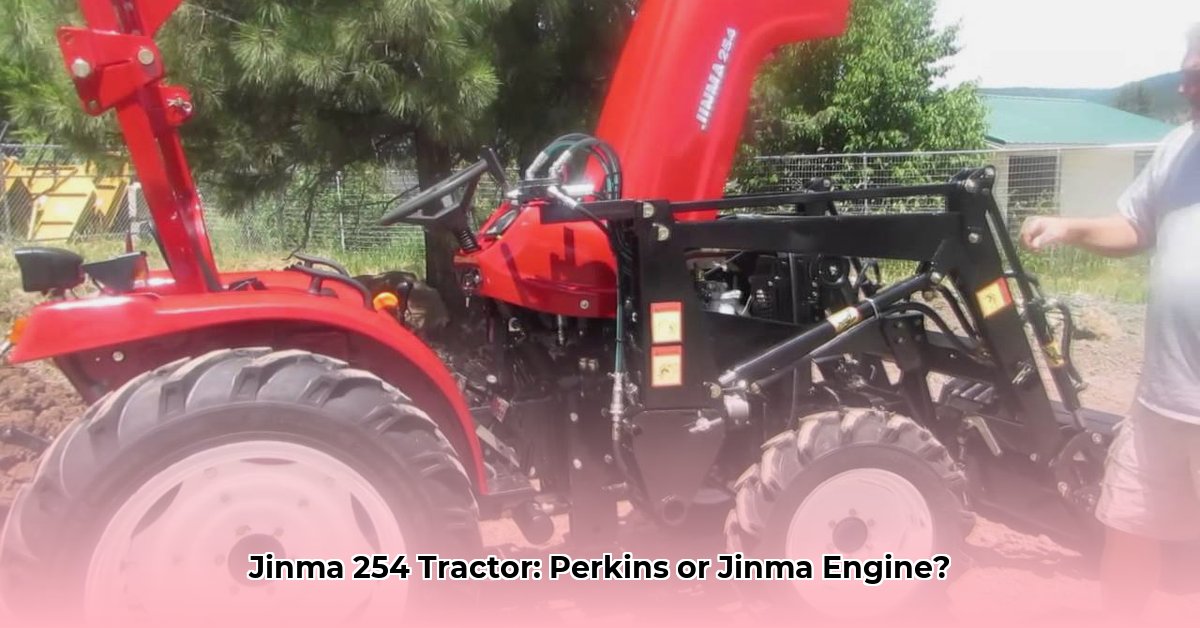
Choosing the right compact tractor can be a significant investment. The Jinma JM-254 offers a choice between two engine options: Jinma and Perkins. This comparative review analyzes the key differences to help you make an informed decision. We'll examine power, fuel efficiency, maintenance, and overall value, considering both budget-conscious and environmentally-minded buyers. For more tractor options, check out this helpful resource: affordable tractor brands.
Power and Performance: A Head-to-Head Look
Both Jinma JM-254 models offer approximately 25 horsepower (hp), sufficient for common small-farm tasks like tilling, mowing, and light hauling (1,200 lb lifting capacity). However, a critical difference lies in the Power Take-Off (PTO) horsepower—the power transmitted to attachments. The Perkins-powered model boasts a significantly higher PTO hp rating of 18.8 hp, meaning more efficient operation of implements like mowers and tillers. The Jinma engine's PTO hp remains unspecified, hindering a direct comparison. This difference potentially translates to faster and more effective work with power-hungry attachments.
Under the Hood: Engine Technology and its Implications
The engine types significantly impact performance and long-term costs. The Perkins-powered Jinma JM-254 utilizes a Tier 4 EPA-compliant engine (meeting stringent emission standards), resulting in cleaner emissions. This is beneficial for the environment and may contribute to better fuel economy, although precise data is currently unavailable. However, this advanced technology may also translate into potentially higher repair and maintenance costs compared to a simpler engine. Conversely, the Jinma-powered model likely offers lower initial purchase costs but lacks detailed emission standard information, making a comprehensive comparison of environmental impact challenging.
Missing Data: Understanding the Limitations
A critical limitation in this comparison stems from the lack of readily available, standardized data. Fuel efficiency (gallons or liters per hour under various operating conditions) and long-term reliability data are scarce, making a precise assessment of total cost of ownership difficult. Further research is necessary to quantify the long-term maintenance and repair requirements of each engine. This data gap ultimately impacts the ability to pinpoint a clear winner based solely on operating expenses.
Making Your Decision: Key Considerations
Selecting the appropriate Jinma JM-254 hinges on several factors:
Budget: The Perkins model likely commands a higher upfront cost than the Jinma model. Carefully consider the initial investment against projected long-term operational expenses.
Service and Repair: Evaluate the availability of qualified mechanics and readily accessible parts for each engine type in your region. Minimizing downtime due to repairs is crucial for operational efficiency.
Environmental Impact: If environmental friendliness is paramount, the Perkins engine's lower emissions make it the more attractive option. However, the total impact needs to be measured against the potential for increased parts costs, given the complexity of the engine.
Long-Term Costs: While initial costs might favor the Jinma engine, factor in potential fuel consumption and maintenance expenses over the lifespan of the tractor. A comprehensive cost-benefit analysis extending beyond the initial purchase price is recommended.
Steps to Choosing Your Jinma JM-254
To make an informed decision, follow these steps:
Determine your budget: Establish a realistic spending limit for both the initial purchase and potential long-term maintenance.
Identify your tasks: List the jobs you anticipate for the tractor, defining necessary horsepower and PTO requirements.
Estimate operating costs: Based on available (though limited) data, roughly estimate fuel and maintenance costs for each model.
Investigate parts availability: Contact local dealers to assess parts availability and service capabilities for both engine types.
Consider a test drive (if possible): Hands-on experience can provide valuable insights into engine performance and handling.
Make your decision: Weigh the pros and cons based on your priorities and budget constraints.
Develop a maintenance plan: Establish a proactive maintenance schedule to extend the lifespan of your investment.
Comparison Table: Jinma JM-254 at a Glance
| Feature | Jinma 254 (Jinma Engine) | Jinma 254 (Perkins Engine) | Notes |
|---|---|---|---|
| Horsepower | ~25 hp | ~25 hp | Sufficient for most small-farm applications |
| PTO Horsepower | Unspecified | 18.8 hp | Significant performance difference for power-intensive attachments |
| Emission Standards | Unspecified | Tier 4 EPA-compliant | Impacts environmental impact and potential long-term fuel efficiency |
| Initial Cost | Likely Lower | Likely Higher | Key consideration relative to long-term costs |
| Maintenance Cost | Potentially Lower | Potentially Higher | Availability of mechanics and parts significantly influences this factor |
| Fuel Efficiency | Unknown | Likely Better (unconfirmed) | Requires further investigation |
| Parts Availability | Varies by region | Varies by region | Essential for minimizing downtime |
Disclaimer: This comparison relies on currently accessible information. Further research, including consulting with Jinma JM-254 owners, is highly recommended before making a final purchase decision.
Additional Considerations: Beyond Engine Type
Remember that the engine is only one component of the overall tractor package. Consider factors like warranty, dealer support, and the specific features offered within each model. Seeking advice from experienced farmers or agricultural professionals can provide valuable perspectives based on real-world usage.